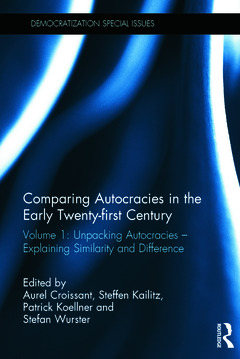Comparing autocracies in the early Twenty-first Century Volume 1: Unpacking Autocracies - Explaining Similarity and Difference Democratization Special Issues Series
Coordonnateurs : Croissant Aurel, Kailitz Steffen, Koellner Patrick, Wurster Stefan

Despite the so-called Third Wave of Democratization, many autocracies have been resilient in the face of political change. Moreover, many of the transition processes that could be included in the Third Wave have reached a standstill, or, at the very least, have taken a turn for the worse, leading sometimes to new forms of non-democratic regimes. As a result of these developments, the research on autocracies has experienced a revival in recent times.
This unique two-volume work aims at taking stock of recent research and providing new conceptual, theoretical, and empirical insights into autocratic rule in the early twenty-first century. It is organized into two parts. The contributions in this first volume analyse the trajectories, manifestations and perspectives of non-democratic rule in general and autocratic rule in particular. It brings together some of the leading authoritarianism scholars in Europe and North America who address three broad questions: How to conceptualize and measure forms of autocratic regimes? What determines the persistence of autocratic rule? What is the role of political institutions, legitimation, ideology, and repression for the survival of different forms of autocratic rule?
This book is an amalgam of articles from the journals Democratization, Contemporary Politics and Politische Vierteljahresschrift.
1. Introduction 2. Authoritarian regime types revisited: updated data in comparative perspective 3. Classifying political regimes revisited: legitimation and durability 4. The three pillars of stability: legitimation, repression, and co-optation in autocratic regimes 5. Informal Institutions in Autocratic Regimes: Concept, Analytical Framework, and the Case of the Communist Party of China 6. Four Basic Types of Autocracy and Their Strategies of Legitimation 7. Ideology after the end of ideology. China and the quest for autocratic legitimation 8. Elections in Authoritarian Regimes: Comparing Post-Soviet Cases 9. Populism and competitive authoritarianism in non-democratic elections
Date de parution : 06-2014
15.6x23.4 cm
Thème de Comparing autocracies in the early Twenty-first Century :
Mots-clés :
Authoritarianism; Autocracy; Legitimation; Regime Persistence; Typologies; Steffen Kailitz; CCP’s Ideology; CCP’s Legitimacy; CCP Member; CCP Central Committee; Chinese Communist Party; Electoral Autocracies; Competitive Authoritarianism; Regime Types; Authoritarian Autocracies; Authoritarian Regime Types; Political Regime Types; Party System Collapse; CCP Central; Anti-establishment Appeal; Informal Institutions; CCP General Secretary; Personalist Autocracy; Intensity Coercion; Sub-regional Cluster; Authoritarian Elections; Party Autocracies; CCP General Secretary Hu Jintao; Combined Freedom House; CCP’s Hegemony



